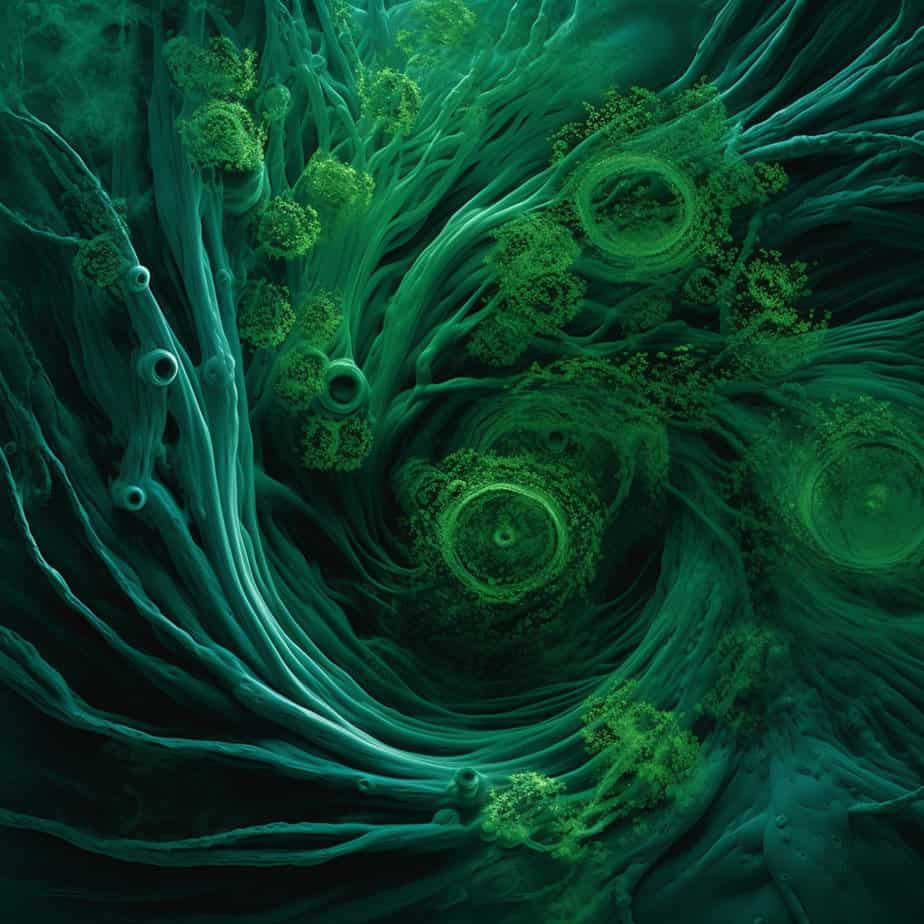Spirulina is a type of blue-green algae that has gained popularity as a superfood due to its rich nutritional content. While it is often referred to as an algae, it is more accurately classified as a cyanobacterium, belonging to the phylum Cyanobacteria. Cyanobacteria are a group of photosynthetic bacteria that can be found in various aquatic environments, including freshwater and marine ecosystems. Phytoplankton, on the other hand, refers to a diverse group of microscopic organisms that perform photosynthesis and form the base of the food chain in aquatic ecosystems. Spirulina, being a photosynthetic organism that thrives in water, can be considered a type of phytoplankton. However, it is important to note that not all phytoplankton are spirulina. Phytoplankton encompasses a wide range of organisms, including diatoms, dinoflagellates, and other types of algae. In this article, we will explore the characteristics of spirulina and its relationship to phytoplankton, highlighting its unique properties and potential benefits. So, let’s dive in and discover more about this fascinating organism.
Key Takeaways
- Spirulina is a type of cyanobacteria that is often classified as a phytoplankton.
- Phytoplankton are microscopic organisms that live in aquatic environments and serve as a vital part of the food chain.
- Spirulina is rich in nutrients and is commonly consumed as a dietary supplement due to its potential health benefits.
- It is important to note that while spirulina is considered a phytoplankton, not all phytoplankton are spirulina.
Understanding Spirulina: A Brief Overview
A. The Origin and Nature of Spirulina
Spirulina is a type of microalgae that has gained popularity in recent years due to its numerous health benefits. This unique organism has a fascinating history and a remarkable composition that sets it apart from other forms of algae.
Believed to have originated billions of years ago, spirulina is one of the oldest life forms on Earth. It thrives in warm, alkaline waters and can be found in various parts of the world, including Africa, Asia, and Central America. The name “spirulina” is derived from its spiral-shaped structure, which is visible under a microscope.
Spirulina is classified as a cyanobacteria, also known as blue-green algae. While it shares some characteristics with algae, it is technically not classified as a true algae. Instead, spirulina is classified as a type of bacteria that can perform photosynthesis. This unique classification is due to its ability to produce energy from sunlight, just like plants.
B. The Classification of Spirulina: Is it a Phytoplankton?
Phytoplankton refers to microscopic organisms that live in aquatic environments and perform photosynthesis. These organisms play a crucial role in the marine food chain, serving as a primary source of food for many marine organisms.
So, is spirulina a phytoplankton? The answer is yes. Spirulina is considered a type of phytoplankton due to its ability to perform photosynthesis and its presence in aquatic environments. However, it is important to note that spirulina is not a typical phytoplankton species found in the ocean. Instead, it is commonly cultivated in controlled environments for commercial purposes.
While spirulina shares some similarities with other phytoplankton species, it also has distinct characteristics that set it apart. Unlike most phytoplankton, which are single-celled organisms, spirulina exists as a multicellular filamentous structure. This unique structure allows it to form colonies and grow in dense populations.
C. Spirulina Planta: A Closer Look
Spirulina is often referred to as a “superfood” due to its exceptional nutritional profile. It is rich in essential nutrients, including protein, vitamins, minerals, and antioxidants. Let’s take a closer look at some of the key components that make spirulina a valuable dietary supplement.
-
Protein Content: Spirulina is an excellent source of protein, containing all essential amino acids. In fact, it is considered one of the most protein-dense foods available, making it a popular choice among vegetarians and vegans.
-
Vitamins and Minerals: Spirulina is packed with vitamins and minerals, including vitamin B12, iron, and calcium. These nutrients are essential for maintaining overall health and supporting various bodily functions.
-
Antioxidants: Spirulina is rich in antioxidants, such as phycocyanin and beta-carotene. These compounds help protect the body against oxidative stress and may have anti-inflammatory properties.
-
Digestive Health: Spirulina contains a high amount of fiber, which can promote healthy digestion and prevent constipation. Additionally, it may have prebiotic effects, supporting the growth of beneficial gut bacteria.
-
Immune System Support: The unique combination of nutrients found in spirulina can help support a healthy immune system. It may enhance immune cell activity and reduce inflammation, potentially boosting the body’s defense against infections.
In conclusion, spirulina is a fascinating organism that falls under the category of phytoplankton. While it shares some characteristics with other phytoplankton species, it also has distinct qualities that make it unique. Its exceptional nutritional profile and potential health benefits have made it a popular dietary supplement worldwide. Whether you’re looking to boost your protein intake, support your immune system, or improve your overall well-being, spirulina is definitely worth considering.
Spirulina vs Marine Phytoplankton: A Comparative Analysis

A. Defining Marine Phytoplankton
Marine phytoplankton refers to the microscopic plant-like organisms that inhabit the world‘s oceans and bodies of water. These tiny organisms are responsible for producing a significant portion of the Earth’s oxygen and form the base of the marine food chain. Phytoplankton are diverse and encompass a wide range of species, each with its own unique characteristics and nutritional profiles.
B. Is Marine Phytoplankton the Same as Spirulina?
While spirulina is often referred to as a type of phytoplankton, it is important to note that spirulina is not technically classified as marine phytoplankton. Spirulina is a type of blue-green algae that belongs to the cyanobacteria family. It is a freshwater organism that thrives in warm, alkaline environments such as lakes and ponds.
C. Key Differences and Similarities
-
Habitat: One of the primary differences between spirulina and marine phytoplankton is their habitat. Marine phytoplankton are found in saltwater environments, whereas spirulina thrives in freshwater habitats.
-
Size: Marine phytoplankton are typically smaller in size compared to spirulina. Phytoplankton can range from a few micrometers to several centimeters in size, while spirulina is generally larger, with individual filaments measuring around 0.5 to 1 millimeter in length.
-
Nutritional Composition: Both spirulina and marine phytoplankton are known for their rich nutritional profiles. However, the specific composition may vary between different species. Spirulina is particularly renowned for its high protein content, making it a popular dietary supplement for vegetarians and vegans. On the other hand, marine phytoplankton species can vary widely in their nutritional content, with some species being rich in omega-3 fatty acids, antioxidants, and other essential nutrients.
-
Cultivation: Spirulina is commercially cultivated on a large scale, often in controlled environments such as ponds or tanks. This allows for consistent production and quality control. In contrast, marine phytoplankton are typically harvested from natural bodies of water, making their availability and cultivation more challenging.
-
Applications: Spirulina is widely used as a dietary supplement and is considered a superfood due to its nutritional value. It is available in various forms, including powder, tablets, and capsules. Marine phytoplankton, on the other hand, is less commonly consumed directly by humans but is often used as a supplement in aquaculture and as a feed source for marine organisms.
In conclusion, while spirulina shares some similarities with marine phytoplankton, it is important to recognize that they are distinct organisms with different characteristics and habitats. Both spirulina and marine phytoplankton offer unique nutritional benefits and have various applications in different industries. Whether you choose to incorporate spirulina or marine phytoplankton into your diet or utilize them in other ways, it is essential to understand their individual properties and potential benefits.
The Health Benefits of Spirulina

Spirulina is a type of blue-green algae that has gained popularity as a superfood due to its numerous health benefits. This microscopic organism, also known as Spirulina platensis, is often classified as a phytoplankton due to its ability to perform photosynthesis and its presence in aquatic environments. Let’s explore the nutritional profile of spirulina and its role in promoting health and wellness.
A. Nutritional Profile of Spirulina
Spirulina is packed with essential nutrients, making it a highly nutritious dietary supplement. Here are some key components of spirulina’s nutritional profile:
-
Protein: Spirulina is an excellent source of plant-based protein, containing all the essential amino acids our bodies need. In fact, it has a higher protein content compared to most other plant-based foods, making it a great choice for vegetarians and vegans.
-
Vitamins: Spirulina is rich in vitamins, particularly B vitamins such as thiamine (B1), riboflavin (B2), and niacin (B3). These vitamins play a crucial role in energy production, brain function, and maintaining healthy skin.
-
Minerals: Spirulina is a good source of minerals like iron, magnesium, and potassium. Iron is essential for transporting oxygen throughout the body, while magnesium and potassium are important for maintaining healthy muscles and regulating blood pressure.
-
Antioxidants: Spirulina contains a variety of antioxidants, including phycocyanin, which gives it its vibrant blue-green color. Antioxidants help protect our cells from damage caused by harmful free radicals, reducing the risk of chronic diseases.
B. What is Spirulina Good For: Health and Wellness Benefits
Spirulina offers a wide range of health benefits due to its nutrient-rich composition. Here are some of the ways spirulina can contribute to your overall well-being:
-
Boosts Immune System: Spirulina contains compounds that can enhance immune function, helping your body fight off infections and diseases. It stimulates the production of antibodies and activates natural killer cells, which play a crucial role in defending against pathogens.
-
Supports Heart Health: The antioxidants found in spirulina, such as phycocyanin, may help reduce inflammation and oxidative stress, both of which are risk factors for heart disease. Additionally, spirulina has been shown to lower bad cholesterol levels and increase good cholesterol levels, promoting a healthy cardiovascular system.
-
Enhances Exercise Performance: Spirulina’s high protein content and antioxidant properties make it a popular supplement among athletes. Studies have shown that spirulina can improve endurance and reduce muscle damage and fatigue, allowing athletes to perform at their best.
-
Aids in Detoxification: Spirulina has been found to have detoxifying effects on the body. It helps eliminate heavy metals, such as arsenic and lead, from the system, reducing their harmful effects on health.
C. The Role of Spirulina Platensis in Health
Spirulina platensis, the specific species of spirulina, has been extensively studied for its potential health benefits. Here are some additional ways in which spirulina platensis can contribute to your well-being:
-
Anti-inflammatory Properties: Spirulina platensis contains compounds that possess anti-inflammatory properties, which can help reduce inflammation in the body. Chronic inflammation is associated with various diseases, including heart disease, diabetes, and certain types of cancer.
-
Anticancer Potential: Some studies suggest that spirulina platensis may have anticancer properties. Its antioxidant and anti-inflammatory properties, along with its ability to enhance the immune system, may help inhibit the growth of cancer cells and reduce the risk of certain types of cancer.
-
Supports Brain Health: Spirulina platensis contains nutrients that support brain health, such as omega-3 fatty acids and antioxidants. These compounds have been shown to protect brain cells from damage, improve cognitive function, and reduce the risk of neurodegenerative diseases like Alzheimer’s and Parkinson’s.
In conclusion, spirulina, although classified as a phytoplankton, offers a wide array of health benefits. Its nutritional profile, including high protein content, vitamins, minerals, and antioxidants, makes it a valuable addition to a healthy diet. From boosting the immune system to supporting heart health and enhancing exercise performance, spirulina has proven to be a versatile and beneficial superfood. Incorporating spirulina into your daily routine may contribute to your overall health and well-being.
Incorporating Spirulina into Your Diet

Spirulina, a type of blue-green algae, is not only a popular dietary supplement but also a versatile ingredient that can be easily incorporated into your daily diet. Whether you’re looking to boost your nutrient intake or simply add a unique twist to your meals, spirulina can be a great addition to your culinary repertoire. In this section, we will explore some creative ideas for using spirulina powder, discuss dosage and safety considerations, and provide tips for choosing high-quality spirulina products.
A. Where to Add Spirulina Powder: Creative Ideas
Spirulina powder can be added to a wide variety of foods and beverages, allowing you to enjoy its health benefits in different ways. Here are some creative ideas for incorporating spirulina into your diet:
-
Smoothies and Juices: One of the easiest ways to incorporate spirulina powder into your diet is by adding it to your favorite smoothies or juices. Simply blend a teaspoon of spirulina powder with your choice of fruits, vegetables, and liquids for a refreshing and nutritious drink. The vibrant green color of spirulina will add an appealing visual element to your beverage.
-
Baked Goods: Spirulina can be used to enhance the nutritional value of your baked goods. Add a tablespoon of spirulina powder to your pancake or waffle batter for a vibrant green twist. You can also mix it into cookie dough, muffin batter, or homemade energy bars for an added boost of nutrients.
-
Sauces and Dressings: Another way to incorporate spirulina into your diet is by adding it to sauces and dressings. Mix a teaspoon of spirulina powder with your favorite salad dressing or pasta sauce for a unique flavor and a nutritional boost. The mild taste of spirulina blends well with savory and tangy flavors.
-
Guacamole and Dips: If you’re a fan of guacamole or other dips, consider adding spirulina powder to give them a nutritional boost. Mix a teaspoon of spirulina powder with mashed avocado, lime juice, and your favorite seasonings for a vibrant and healthy dip. Serve it with vegetable sticks or whole-grain crackers for a nutritious snack.
-
Soups and Stews: Spirulina powder can also be added to soups and stews to enhance their nutritional content. Simply sprinkle a teaspoon of spirulina powder into your favorite soup or stew during the cooking process. The heat will help to incorporate the powder into the dish, giving it a vibrant green color and added nutrients.
B. Dosage and Safety Considerations
While spirulina is generally considered safe for most people, it’s important to follow the recommended dosage and consider any potential safety concerns. Here are some dosage and safety considerations to keep in mind:
-
Recommended Dosage: The recommended dosage of spirulina can vary depending on the brand and form (powder, tablets, capsules). It’s best to follow the instructions provided by the manufacturer or consult with a healthcare professional for personalized advice. As a general guideline, starting with a small dosage (e.g., 1-2 grams per day) and gradually increasing it can help your body adjust to spirulina.
-
Quality and Purity: When choosing spirulina products, opt for reputable brands that prioritize quality and purity. Look for products that are third-party tested for contaminants and adhere to strict manufacturing standards. This ensures that you’re getting a high-quality product free from harmful substances.
-
Potential Side Effects: While spirulina is generally well-tolerated, some individuals may experience mild side effects such as digestive issues, nausea, or allergic reactions. If you’re new to spirulina or have any underlying health conditions, it’s advisable to start with a small dosage and monitor your body’s response. If you experience any adverse effects, discontinue use and consult with a healthcare professional.
-
Interactions and Precautions: If you’re taking any medications or have pre-existing health conditions, it’s important to consult with a healthcare professional before adding spirulina to your diet. Spirulina may interact with certain medications or supplements, and individuals with certain conditions (e.g., autoimmune disorders) may need to exercise caution.
C. Tips for Choosing High-Quality Spirulina Products
To ensure that you’re getting the most out of spirulina’s nutritional benefits, it’s essential to choose high-quality products. Here are some tips to help you select the best spirulina:
-
Source and Origin: Look for spirulina products that are sourced from reputable suppliers and produced in countries with strict quality control measures. Spirulina cultivated in controlled environments, such as freshwater ponds or tanks, tends to be of higher quality compared to wild-harvested spirulina.
-
Certifications and Testing: Check if the spirulina product has undergone third-party testing for purity, contaminants, and nutritional content. Look for certifications such as Good Manufacturing Practices (GMP) and organic certifications, which ensure that the product meets specific quality standards.
-
Packaging and Storage: Opt for spirulina products that are packaged in airtight containers to protect them from moisture and light. Proper storage is crucial to maintain the potency and freshness of spirulina. Follow the storage instructions provided by the manufacturer to ensure the product‘s quality.
-
Reviews and Reputation: Read customer reviews and testimonials to get an idea of the product‘s quality and effectiveness. Look for reputable brands with positive feedback from consumers. Additionally, consider seeking recommendations from healthcare professionals or trusted sources.
Incorporating spirulina into your diet can be a fun and nutritious way to enhance your overall well-being. By exploring creative ideas for using spirulina powder, understanding dosage and safety considerations, and selecting high-quality products, you can reap the benefits of this superfood while enjoying delicious and wholesome meals. Remember to consult with a healthcare professional if you have any specific health concerns or questions about incorporating spirulina into your diet. Conclusion
In conclusion, spirulina is indeed a type of phytoplankton. It is a microscopic, spiral-shaped, blue-green algae that thrives in both fresh and saltwater environments. Spirulina is rich in essential nutrients, such as proteins, vitamins, minerals, and antioxidants, making it a popular dietary supplement and superfood. Its ability to photosynthesize and produce oxygen, along with its role as a primary producer in aquatic ecosystems, classifies it as a phytoplankton. Spirulina’s unique characteristics and nutritional profile make it a valuable resource for both human consumption and environmental sustainability. As research on spirulina continues to expand, its potential benefits and applications are being further explored, making it an intriguing subject for scientific study and innovation.
Frequently Asked Questions
Q1: Is spirulina a phytoplankton?
Yes, spirulina is a type of blue-green algae, which is a form of phytoplankton. It’s a microscopic plant-like organism that lives in fresh and salt water.
Q2: Where can I add spirulina powder?
Spirulina powder can be added to a variety of foods and drinks. It’s commonly added to smoothies, juices, salads, or even mixed into yogurt. It can also be incorporated into baked goods for an extra nutritional boost.
Q3: Is marine phytoplankton the same as spirulina?
No, marine phytoplankton and spirulina are not the same. While both are types of microalgae, marine phytoplankton is typically found in oceans and seas, whereas spirulina is usually found in freshwater environments like ponds and lakes.
Q4: What does ‘spirulina planta’ mean?
‘Spirulina planta‘ is a term used to refer to spirulina as a plant. However, it’s important to note that spirulina is technically a type of blue-green algae, not a plant.
Q5: What is spirulina good for?
Spirulina is known for its high nutritional content. It’s a rich source of protein, vitamins, minerals, and antioxidants. It can support immune function, boost energy levels, and promote heart health. It’s often referred to as a superfood due to its numerous health benefits.
Q6: What is Spirulina platensis?
Spirulina platensis is a specific species of spirulina. It’s a type of blue-green algae that’s often used as a dietary supplement due to its high protein content and other nutritional benefits.
Q7: How does spirulina compare to other phytoplankton in terms of nutrition?
Spirulina is often compared to other phytoplankton due to its high nutritional content. While the specific nutrients can vary between species, spirulina is generally higher in protein and contains a wide range of vitamins and minerals.
Q8: What are the health benefits of phytoplankton?
Phytoplankton, including spirulina, are rich in nutrients such as omega-3 fatty acids, amino acids, vitamins, and minerals. They can support heart health, boost the immune system, and promote overall wellness.
Q9: How does the protein content of spirulina compare to other foods?
Spirulina is a rich source of protein, with about 60-70% of its dry weight being protein. This is higher than most traditional sources of protein, including beef and chicken.
Q10: Can spirulina and other phytoplankton be used as dietary supplements?
Yes, both spirulina and other types of phytoplankton can be used as dietary supplements. They are often taken in powder or tablet form to boost nutritional intake and promote overall health.




